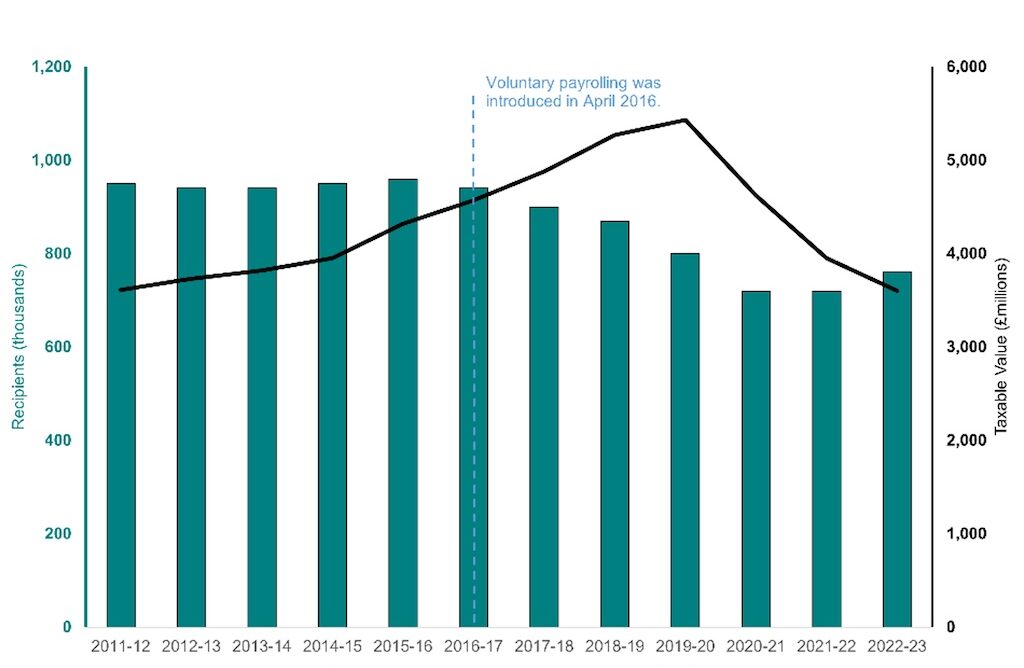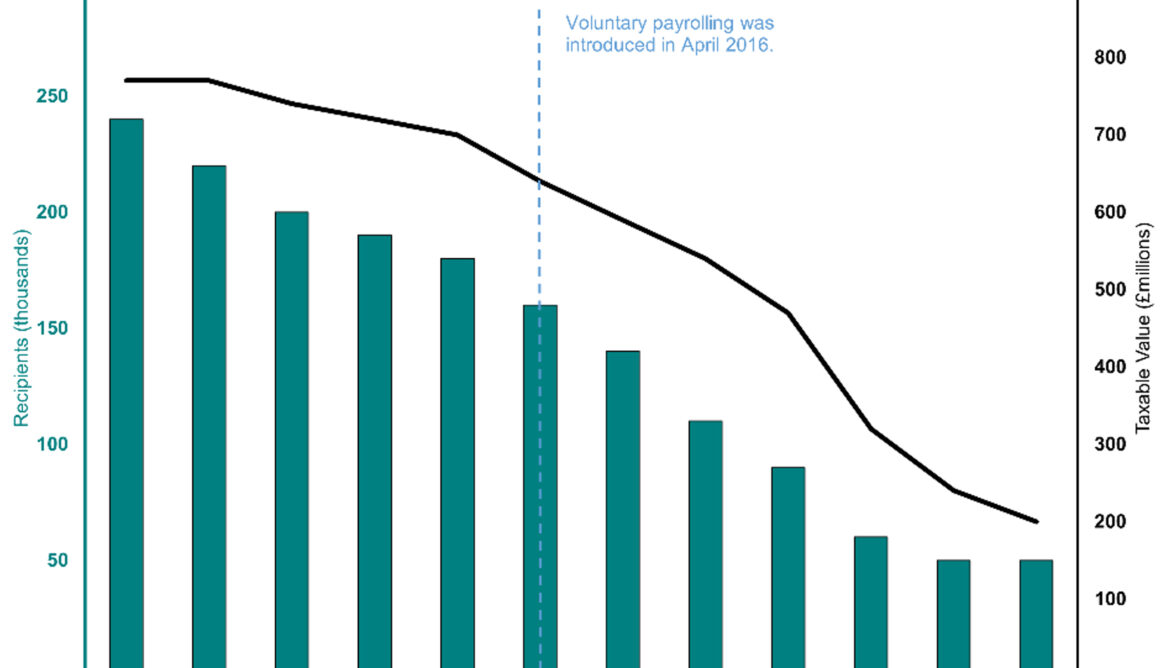Company car take-up rebounds on back of meteoric sal-sac demand
Following years of declines and stagnation, the number of company car takers in the UK has risen due to soaring demand for salary sacrifice and the shift to electric cars.

The total number of reported recipients of company car benefit was 760,000; up 40,000 from the previous year
Newly published HMRC figures reveal that 760,000 UK employees paid company car tax in 2022/23 – that’s up by 40,000 or 5.6% from the figure of 720,000 in 2021/22 and 2020/21 and follows years of steady decline.
Back in 2015/16, there were 960,000 drivers paying company car tax but rising tax thresholds and the diesel surcharge led to many drivers opting out in some form and running their own grey fleet cars.
Paul Hollick, chair of the Association of Fleet Professionals (AFP), said: “It’s been predicted by industry experts for a while that low electric car benefit in kind taxation would lead to an increase in company car numbers and this is now becoming a reality, the new figures show.
“A 5% uplift is quite a dramatic reversal in the long-term trend and underlines how company cars today provide a means of highly flexible, good value and increasingly, zero emissions transport for UK businesses – as well as being a highly valued part of employee benefits packages.
“It’ll be fascinating to see how the trend develops in future HMRC statistics, especially as interest in salary sacrifice schemes continues to grow.”
HMRC has warned of a slight complication in comparing company car take-up due to incomplete figures arising from the introduction of voluntary payrolling in April 2016. This meant there was no requirement to report the details of voluntarily payrolled company cars until April 2018 and may have led to “considerable unreporting”. HMRC has previously stressed that the appropriate tax was collected but car benefit not recorded and said this may account for some of the reduction in company cars since tax year 2015/2016.
Covid may have also been behind a big drop in company car takers for 2020/21 when the figure dropped 10% or 80,000 drivers from 800,000 in the previous year.
Figure 1: Number of recipients and total taxable value of company cars (from April 2011)

Source: HMRC
| Year | Recipients (thousands) | Taxable value (£millions) |
| 2011 to 2012 | 950 | 3,610 |
| 2012 to 2013 | 940 | 3,730 |
| 2013 to 2014 | 940 | 3,820 |
| 2014 to 2015 | 950 | 3,950 |
| 2015 to 2016 | 960 | 4,320 |
| 2016 to 2017 | 940 | 4,570 |
| 2017 to 2018 | 900 | 4,880 |
| 2018 to 2019 | 870 | 5,270 |
| 2019 to 2020 | 800 | 5,430 |
| 2020 to 2021 | 720 | 4,620 |
| 2021 to 2022 | 720 | 3,950 |
| 2022 to 2023 | 760 | 3,600 |
Key factors in the newly reported rise in company car take-up include low tax ratings for low-emission cars, spearheaded in April 2020 by the 0% Benefit-in-Kind rate for fully electric cars, which moved to a 1% threshold in 2021/22, is currently at 2% for the 2024/25 year and will reach 5% by 2027/28, as announced in the 2022 Autumn Statement following industry lobbying. Thresholds after then have not been set out – and the Association of Fleet Professionals (AFP) has said extended BiK tax tables should be a priority among fleet jobs for the new government.
Such low BiK rates have been a financial ‘game-changer’ for EV leasing, in particular salary sacrifice schemes that deliver major tax savings for drivers. The BVRLA’s latest quarterly Leasing Outlook report, published in April, revealed Q4 2023 salary sacrifice car volumes surged by 47% year on year, while the business contract hire fleet posted a 7.1% YoY rise.
Commenting on the new HMRC figures, Toby Poston, BVRLA’s director of corporate affairs, said: “It is encouraging to see the numbers back on the up. It does not come as a surprise though, data in the BVRLA’s quarterly Leasing Outlook reports mirrors this uplift and show that the trend is continuing. Securing foresight of Benefit in Kind rates up to FY 2027/28 has undoubtedly been a key driver of the movement, bringing confidence and transparency at a time of constant change elsewhere.
“The company car market is underpinned by vehicle leasing and has always set the pace for the adoption of new technology. Supported by fair Benefit-in-Kind rates on electric vehicles it is again leading the way, bringing cleaner, greener cars to the UK’s roads.”
Population of company cars now significantly more efficient
HMRC’s new BiK stats illustrate that more employees are switching onto the tax-saving benefits of fully electric cars, which accounted for 29% of car benefit recipients in 2022/23.
Despite the rise in company car takers in 2022/23, the total taxable value of company car benefit was £3.60bn, down from £3.95bn in 2021/2022 and down even further long term. Over the period from tax year 2011/2012 to tax year 2019/2020, the total taxable value of reported company cars increased significantly from £3.61bn to £5.43bn – that rise had been due to increases in the ‘appropriate percentages’ used to calculate the taxable value of a company car, and to a lesser extent increases in the average car list price.
The HMRC figures also reveal that in the 2022/2023 tax year, only around 2% of company cars had reported CO2 emissions in excess of 165g/km. By contrast in 2002 to 2003, 58% of company cars had reported emissions in excess of 165g/km.
Furthermore, the average reported CO2 emission of company cars including electric cars was 71g/km in 2022/23, compared to 86g/km in the previous tax year. For cars with internal combustion engines the average was 99g/km.
The number of reported recipients of company cars with CO2 emissions of 75g/km or less was 369,000 (up from around 243,000 in the previous tax year).
Diesel has continued its steady decline. The erstwhile fleet favourite for its tax benefits – diesel accounted for 80% of company cars in 2017 – has dwindled to a 23% share for 2022/23.
Other findings from the HMRC stats include a plateau in the number of reported fuel benefit recipients. This stood at 50,000 takers in 2022/2023; the same as the previous year, although there has been a steady decline from 240,000 in 2011/2012. The shift towards electric-powered cars is expected to be in part behind the decline in fuel benefit use.
Figure 2: Number of recipients and taxable value of fuel benefit (since April 2011)

Source: HMRC
| Year | Recipients (thousands) | Taxable value (£ millions) |
| 2011 to 2012 | 240 | 770 |
| 2012 to 2013 | 220 | 770 |
| 2013 to 2014 | 200 | 740 |
| 2014 to 2015 | 190 | 720 |
| 2015 to 2016 | 180 | 700 |
| 2016 to 2017 | 160 | 640 |
| 2017 to 2018 | 140 | 590 |
| 2018 to 2019 | 110 | 540 |
| 2019 to 2020 | 90 | 470 |
| 2020 to 2021 | 60 | 320 |
| 2021 to 2022 | 50 | 240 |
| 2022 to 2023 | 50 | 200 |
The average taxable values for car benefit and car fuel benefit in 2022/2023 were £4,750 and £4,260 respectively; down from £5,520 and £4,660 the year prior.
Overall, the total taxable value of all Class 1A taxable Benefits-in-Kind was £9.1bn, an increase of £0.7bn from the previous year.














